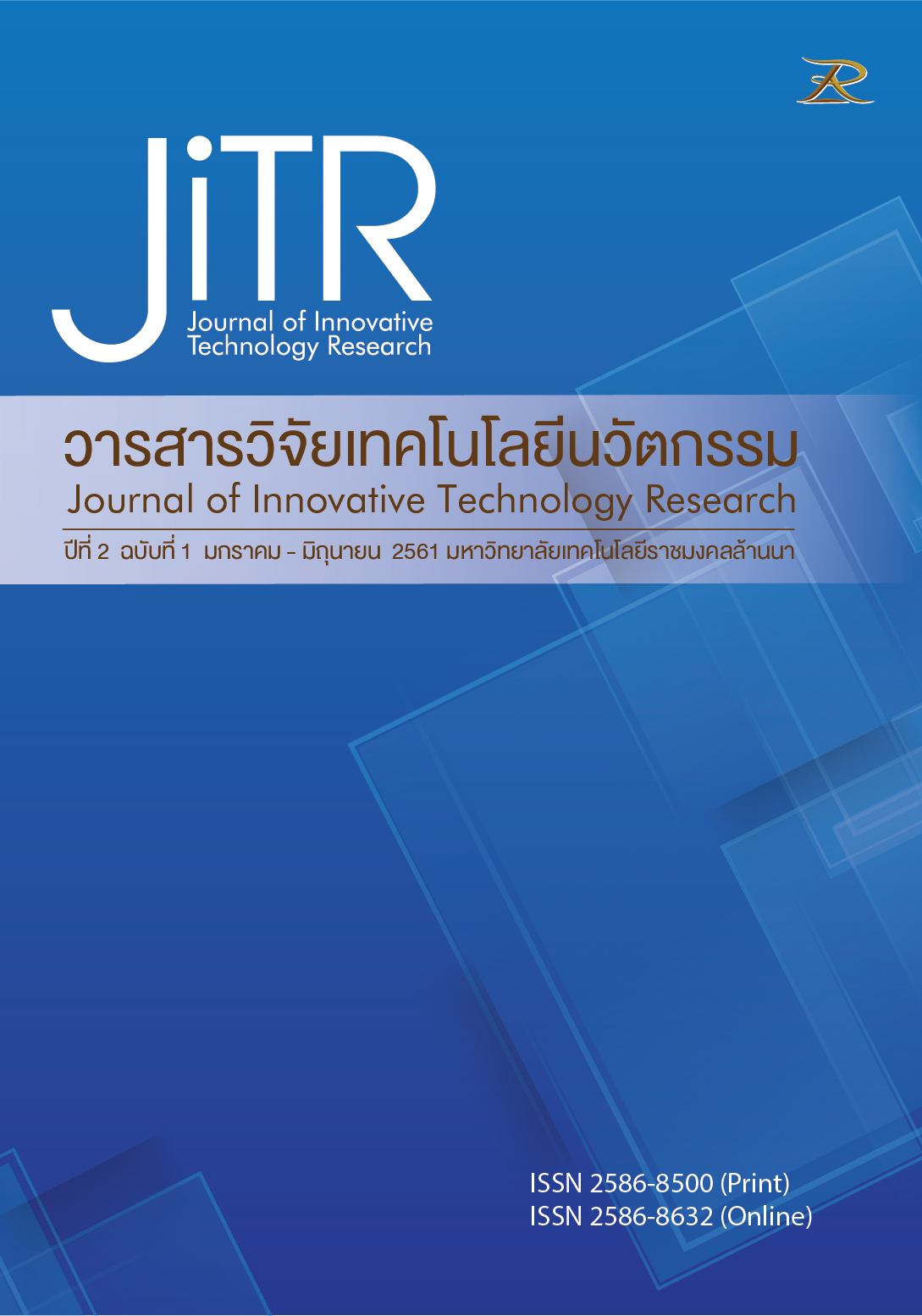การออกแบบและสร้างต้นแบบระบบการฆ่าเชื้อจุลีนทรีย์ ด้วยสนามไฟฟ้าพัลส์ ระดับอุตสาหกรรม
คำสำคัญ:
สนามไฟฟ้าพัลส์, อาหารเหลว, ฆ่าเชื้อจุลินทรีย์บทคัดย่อ
งานวิจัยนี้มีวัตถุประสงค์หลักเพื่อออกแบบและสร้างต้นแบบระบบการฆ่าเชื้อจุลีนทรีย์ในอาหารเหลวด้วยสนามไฟฟ้าพัลส์ระดับอุตสาหกรรม โดยออกแบบโครงสร้างให้ไม่ซับซ้อน มีจำนวนชิ้นส่วนประกอบน้อย ต้นทุนในการสร้างถูก การบำรุงรักษาต่ำ และมีความปลอดภัยต่อผู้ปฏิบัติงาน โครงสร้างทำจากสเตนเลส มีขนาด กว้าง 0.9 ยาว 1.4 และสูง 1.8 (เมตร) ระบบสนามไฟฟ้าแบบพัลส์ประกอบด้วยระบบควบคุม (Control system), แหล่งจ่ายไฟฟ้าแรงดันสูงแบบพัลส์ (High soltage sulse senerator), ตัวปรับแรงดันไฟฟ้า (Variacs), ตัวเก็บประจุ (Capacitor), ชุด Spark gaps, ไดโอด (Diode), ตัวต้านทาน (Resistor), ห้องฆ่าเชื้อ (Treatment chamber) แบบไหลต่อเนื่อง,ปั๊มควบคุมการไหลของอาหารเหลว (Pump), อุปกรณ์วัดอัตราการไหล (Flow meter), เทอร์โมมิเตอร์ (Thermometer) และถังบรรจุอาหารเหลวทั้งก่อนและหลังกระบวนการ (Initial and treated liquid food) โดยคุณสมบัติของระบบที่สร้างขึ้นมีความเข้มของสนามไฟฟ้ามากกว่า 25 kV/cm แรงดันไฟฟ้าที่ขั้วอิเล็กโทรดไม่เกิน 20 kV กระแสไฟฟ้าสูงสุดด้านเอาต์พุต ไม่เกิน 2 kA ที่ความกว้างพัลส์ประมาณ 2.5 µs ความถี่พัลส์อยู่ในช่วง
0.5 – 2 Hz ศักย์ไฟฟ้าขั้วบวก ความดันของอาหารเหลวประมาณ 1 bar อัตราการไหลของอาหารเหลวประมาณ 1 – 5 L/min อัตราการผลิต 60 – 300 L/hr และความหนาแน่นของพลังงาน 10n kJ/L (n ;จำนวนพัลส์)
References
2. M. Walkling-Ribeiro, F. Noci, J. Riener, D. A. Cronin, J. G. Lyng and D. J. Morgan, The Impact of Thermosonication and Pulsed Electric Fields on Staphylococcus aureus Inactivation and Selected Quality Parameters in Orange Juice, Food Bioprocess Technology, vol 2, October 2009, pp. 422–430
3. J. Mosqueda-Melgar, R. M. Raybaudi-Massilia and O. Martín-Belloso, “Non-thermal Pasteur-ization of Fruit Juices by Combining High-intensity Pulsed Electric Fields with Natural Antimicrobials,” Innovative Food Science and Engineering Technologies, vol. 9, 2008., pp. 328 – 340,
4. Yongguang Y and Guidan He. A fast high-intensity pulsed electric fields (PEF)-assisted extraction of dissoluble calcium form bone, Separation and Purification Technology, vol 61, October 2008 pp. 148–152
5. Kempkes M. A., Pulsed electric field (PEF) systems for commercial food and juice processing, Diversified Technologies, Inc., USA: Woodhead Publishing Limited, 2010
6. เจษฏา ชินรุ่งเรือง, พิมพ์ครั้งที่3, 2557, บทที่ 5 เรื่อง วงจรอันดับหนึ่ง RL และ RC , ทฤษฎีวงจรไฟฟ้าเบื้องต้น,สำนักพิมพ์จุฬาลงกรณ์วิทยาลัย, ISBN 974-9941-06-3
7. Qinghua Z, Gustavo V, and Berry G.S, Engineering Aspects of Pulsed Electric Field Pasteurization, Journal of Food Engineering, vol 94, May 1995 pp. 261–281
8. Jose A.G, David R.S, Maria M.G, Barry S and Gustavo V.B, Milk thermization by pulsed electric fields (PEF) and electrically induced heat, Journal of Food Engineering, vol 100, March 2010 pp. 56–60
9. Intra P, Yawootti A, Asanavijit V, Manopian P, Pengmanee C, Somsri N. Inactivation of E. coli in Milk Tea Undergoing Pulsed Electric Field Pasteurization, KMUTNB J.2015; Vol. 25, No. 3, Sep. - Dec. Thai.
10. Panyamuangjai V, Janthara S, Kusuya R, Yawootti A,. Intra P. Application of Pulsed Electric Field for Milk Pasteurization, KMUTT Res and Dev J, 2012; vol. 35, no. 4, 469-484, Thai.
11. Barbosa-canovas G.V, Pothakamury U.R. Palou E, Swanson B.G. Non-thermal Preservation of Food, New York: Marcel Dekker, 1998.
12. Addeo K. M. Process for the use of pulsed electric fields coupled with rotational retorting in processing meals ready to eat (MRE). U.S., US6083544A (Patent) 2000.
Downloads
เผยแพร่แล้ว
How to Cite
ฉบับ
บท
License
กองบรรณาธิการขอสงวนสิทธิ์ในการปรับปรุงแก้ไขตัวอักษรและค่าสะกดต่าง ๆ ที่ไม่ถูกต้อง และต้นฉบับที่ได้รับการตีพิมพ์ในวารสารเทคโนโลยีและนวัตกรรม ถือเป็นกรรมสิทธิ์ของสถาบันวิจัยและพัฒนา มหาวิทยาลัยเทคโนโลยีราชมงคลล้านนา และผลการพิจารณาคัดเลือกบทความตีพิมพ์ในวารสารให้ถือเป็นมติของกองบรรณาธิการเป็นที่สิ้นสุด




